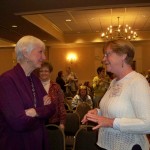Segueing from Melissa’s recent post about tips for becoming a connected teacher librarian, I have a few examples of collaboration that demonstrate a shift from the individual (library) classroom to the global stage. This shift is possible due to the willingness for educators to share best practices for effective teaching and learning through social media, as we have continued to highlight in this blog.
According to Tom Whitby, in a post on Edutopia in early October 2014, connectedness begins with collaboration. “The idea of collaboration requires a mindset of believing there is room to learn and grow. It is also a belief that we are smarter collectively than individually.” Technology has made collaboration much easier than in the past, and “a teacher who benefits from collaboration tends to appreciate its effect, and will use it in his or her own methodology.”
One of the core beliefs that Whitby uses to describe the connected educator, really resonates with me. “A relevant educator is willing to explore, question, elaborate, and advance ideas through connections with other educators.” Every day, when I check my Twitter, Feedly, or Google+ feeds, I am amazed at the exchange of ideas in the global and local school library network. It is like a fire hose, so I have to sort through and choose that which I need, and save others for future reference in my Diigo files-with just a click of the mouse, or a tap on the smartphone or tablet.
Here are just a few of the many “relevant” opportunities to explore, question,and elaborate ideas that I have appreciated in October through my social media/real world:
- Connected Librarian Day, October 7: Hosted by the Library 2.0 website, an international gathering of librarians, educators, and library supporters took place in a virtual environment. If you did not have time to tune in, not to fear, recordings of all the sessions are available, along with links to other resources. Many speakers are shining stars in the school library field, so have a listen, learn, and leave a comment.
- AASL Fall Forum Oct. 17-18: School Librarians in the Anywhere, Anytime Landscape. To get an idea of how ideas were explored, take a look at the AASL Blog and the SLM Blog for several posts from different points of view. It was an ambitious task to collaborate via teleconferencing between sites around the United States. Lots of great reviews for Best Websites 2014. Read the blogs and follow the links to see some of the unique ways ideas were shared, both face to face and virtually. Twitter Hashtag #aasl14.
- School Library Journal Summit 2014 Oct. 25 & 26: Fire It Up! Sparking Creativity & Motivating Students. If you could not make it, Joyce Valenza has shared some of the key takeaways in her blog, The Neverending Search. Also, Shelley Diaz ( SLJ Reviews Editor) has links to resources and presentations, Scenes and Resources From the Summit. It’s so great to share!
- Buffy Hamilton, The Unquiet Librarian, has been sharing her collaborative journey with a co-teacher in her blog. Throughout the month of October, she has been posting the step by step lessons that she and her colleague are using with high school students to introduce them to the inquiry and research process. Photos, videos, and sample strategies for self selecting and narrowing topics are explored. Buffy’s honest reflection of the successes and challenges of each day’s tasks are well developed and we can all learn from their collaborative expertise. Each time she posts, I am excited to see what happens next-sort of like being a fly on the wall!
I know that there have been many other events that get the brain juices flowing in October, and I’d like to hear from you about an event or a learning opportunity that you have enjoyed recently-in any dimension. How about sharing some ideas here? Leave a comment, I‘d love to learn more!
Resources:
AASL Fall Forum, American Library Association, Oct 17, 2014. (Website) http://www.ala.org/aasl/conferences/fall-forum (Accessed Oct. 27, 2014)
“Best Websites for Teaching & Learning 2014.” American Association of School Librarians. (Website) http://www.ala.org/aasl/standards-guidelines/best-websites/2014#media (Accessed Oct. 27, 2014)
Brennan, Lindsay. “AASL Fall Forum-First-time Attendee Reports,” AASL Blog. (Web log) October 17, 2014. http://www.aasl.ala.org/aaslblog/?p=5114 (Accessed Oct. 27, 2014)
“Connected Librarian Day, Oct. 7, 2014.” Library 2.0 (Website) http://www.library20.com/page/connected-librarian-day (Accessed Oct. 27, 2014)
Diaz, Shelley. Scenes and Resources From the Summit,” School Library Journal. (Website) http://www.slj.com/2014/10/resources/scenes-and-resources-from-the-summit-slj-summit-2014/ (Accessed Oct. 27, 2014)
Hamilton, Buffy. “Inquiring with Students: What Do or Can ‘Good’ Research Projects Look Like?” Unquiet Librarian. (Weblog) Sept. 29, 2014. http://theunquietlibrarian.wordpress.com/2014/09/29/inquiring-with-students-what-do-or-can-good-research-projects-look-like/ (Accessed Oct. 27, 2014)
Morris, Rebecca. “AASL Fall Forum,” School Library Monthly Blog. (Web log) Oct. 18, 2014. http://blog.schoollibrarymedia.com/index.php/2014/10/18/aasl-fall-forum/ (Accessed Oct. 27, 2014)
“SLJ Leadership Summit Fire it Up: Sparking Creativity and Motivating Students, Oct. 25 & 26, 2014.“ School Library Journal. (Website) http://www.slj.com/leadership-summit/ (Accessed Oct. 27, 2014)
Valenza, Joyce. “Live From the Summit,” The Neverending Search. (Web log) Oct. 25, 2014. http://blogs.slj.com/neverendingsearch/2014/10/25/live-from-the-summit/ (Accessed Oct. 27, 2014)
Whitby, Tom. “The Connected Educator: It Begins with Collaboration,” Edutopia. (Weblog) October 1, 2014. http://www.edutopia.org/blog/connected-educator-begins-with-collaboration-tom-whitby (Accessed Oct. 27, 2014)
Image: Judith Kaplan Collection




